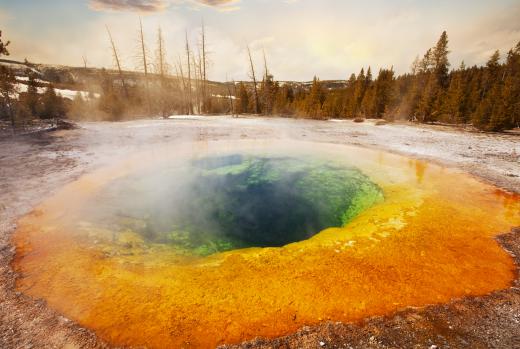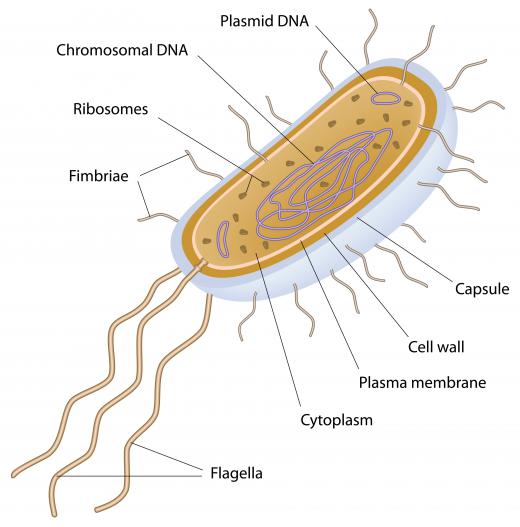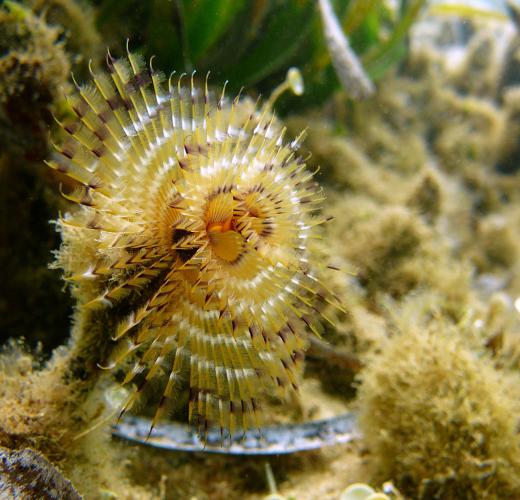What is Chemosynthesis?
 Michael Anissimov
Michael Anissimov
Chemosynthesis is a process certain organisms use to obtain energy for the production of food, akin to photosynthesis, but without the use of sunlight. The energy comes from the oxidization of inorganic chemicals that the organisms find in their environment. The process occurs in many bacteria, and in another group of organisms known as archaea. The life forms that use this method to obtain energy are found in a variety of environments, including soil, the intestines of mammals, petroleum deposits, and in extreme conditions, such as around hydrothermal vents on the ocean floor. They are adapted to circumstances which may have been commonplace billions of years ago, leading some scientists to theorize that they may be direct descendants of the earliest life on Earth.
Methods

Organisms that make their own food out of inorganic chemicals, as opposed to using already existing organic materials, are known as autotrophs. The foods consist of carbohydrates, such as glucose, but these require energy to manufacture. Where sunlight is available, autotrophs will generally use it to perform photosynthesis, but in places where no light reaches, different types have evolved that use chemical energy instead. The life forms that do this are known as chemautotrophs. A number of different methods have arisen, determined by the conditions, and the chemicals that are available.

Chemosynthesis uses oxidation-reduction reactions, also known as redox reactions, to supply the energy required to manufacture carbohydrates out of carbon dioxide and water. This kind of reaction involves the loss of electrons from one substance and the adding of electrons to another. The substance receiving the electrons — usually oxygen — is said to have been reduced, while the one supplying them has been oxidized. Reduction requires energy, but oxidation releases it. The two reactions always occur together, but those used in chemosynthesis result in an overall release of energy.

As with photosynthesis, the actual reactions are very complex and involve a number of steps, but they can be summarized in terms of the raw materials and the end products, one of which will be food in the form of some kind of carbohydrate. Where sulfides are available, they may be oxidized, producing sulfur or sulfates. Iron can also be oxidized, from a form known as iron II to iron III, which has one less electron. Methane, which is present in some places as natural gas, can be a source of both energy and carbon for some microorganisms, and is also a byproduct of chemosynthesis by some other organisms. The oxidation of ammonia to nitrites and nitrates is another method that provides energy for some life forms.

Many of the organisms that use chemosynthesis to manufacture food live in environments with extreme temperatures, pressures, salinity or other conditions that are hostile to most life. These are known as extremophiles. They have various adaptations that enable them to survive, such as unusual enzymes that are not deactivated by high temperatures.
Environments
Hydrothermal vents are among the planet’s most remarkable environments. They consist of streams of hot, chemical-rich water pouring out from the ocean floor in geologically active areas, such as mid-oceanic ridges. Although seemingly hostile to life, with no light, temperatures approaching 212°F (100°C), and full of chemicals that are toxic to most life forms, they have thriving and diverse ecosystems supported by chemosynthetic microorganisms. These microbes consist of bacteria, and also archaea, a very ancient group of organisms that are superficially similar, but chemically and genetically very different.
The hot water produced by hydrothermal vents is very rich in sulfides, which the microbes use for chemosynthesis, sometimes releasing methane as a byproduct. The microorganisms that produce this gas are known as methanogens. Other chemosynthetic microbes in this environment obtain energy by the oxidation of methane, converting sulfate to sulfide in the process. Methane oxidation also takes place in areas where petroleum — a mixture of hydrocarbons including methane — seeps upward into the sea floor.
The ecologies surrounding deep-sea vents are much richer than those further away from such chemical sources, which must survive solely on dead organic matter slowly descending from the waters above. Chemosynthetic life forms not only provide the foundation for larger communities of organisms that consume the microbes to survive, but also form important symbiotic relationships with other organisms. One interesting example is the tubeworm, which starts life with a mouth and gut, which it uses to take in huge numbers of chemosynthetic bacteria. At a later stage, it loses its mouth, and continues to survive by consuming the food produced by its internal bacteria.
Chemosynthetic extremophile microorganisms have been found in hot springs, where they survive by the oxidation of sulfur or ammonia, and in rocks deep below the surface, where they obtain energy by oxidizing iron. Chemosynthesis also takes place in more familiar places. For example, in the soil, nitrifying bacteria convert ammonia into nitrites and nitrates, while methane-generating archaea can be found in marshes and swamps, in sewage and in the intestines of mammals.
Importance and Possible Uses
Nitrifying bacteria in the soil provide useable nitrogen for plants and are a crucial part of the nitrogen cycle — without them, plants and animals could not exist. It is very possible that the earliest life forms used chemosynthesis to create organic compounds out of inorganic ones, and so these processes may be responsible for the establishment of life on Earth. Scientists have suggested a number of ways in which chemautotrophs could be put to good use. For example, they could be used to generate methane for fuel. Since many of these organisms live on chemicals that are toxic to humans, and release harmless byproducts, they might also be used to detoxify certain types of poisonous waste.
Chemosynthesis and Other Planets
The ability of some chemosynthetic organisms to thrive in extreme conditions has led some scientists suggest that such life forms might exist on other planets, in environments that would not be suitable for more familiar types of life. Experiments suggest that some chemosynthetic organisms might be able to survive and grow beneath the surface of Mars, and it has been speculated that traces of methane found in the Martian atmosphere might be the result of activity by methanogenic microorganisms. Another possible location for extraterrestrial life is Jupiter’s ice-covered moon, Europa, where liquid water is thought to exist under the surface.
AS FEATURED ON:
AS FEATURED ON:














Discussion Comments
Chemosynthesis only takes place in the ocean? Why? Because it only takes place in the ocean, at what depth would the process begin?
Thank you so much! This is a great site and gives great easy to understand information. Info on chemosynthetic bacteria is really hard to find and when you do find it, you can barely understand all the technical terms. If you could give some more info on the environment in which this bacteria lives in it would be great!
Thank you. This is one of the only sites i could find with info that was clear, understandable, and gave me what i needed.
I have a terrible fear that a Wall Street Geek looked at the history of the Transcontinental Railroad where 50 million bison were destroyed and the American Indians were decimated and said we can do the same thing in the Gulf.
Sherlock Holmes said to Watson, When you rule out the probable only the improbable remains. But just like mission accomplished in Iraq, these guys didn't take into account that oil eating bacteria would adapt and adopt the corex dispersal and feed off all that oil to become a WMD that once hurricane season starts will contaminate the crops, livestock and fresh water sources.
If our hemoglobin ruptures don't we die of asphyxia? Tell me I am crazy.
thanks. i'm working on a deep sea marine biology project and this helped a lot. thanks
The information given here is not all correct. for example, not all bacteria are chemosynthetic.
good article. easy to understand and very straightforward.
wow, this really helped, thanks whoever wrote it.
you have made my research easier. the topic is clear and easy to understand. excellent
thanks! it's brief and easy to understand.
That helped so much like totally! it really makes sense now! thanks for the help!
Great explanation, simple and easy, but what if they only live in the ocean?
I'm doing a school project when we create an animal, and mine's a bird.
Thanks, this is just what i was searching for for my biology assignment. Simple and easy to understand. Good job
Post your comments